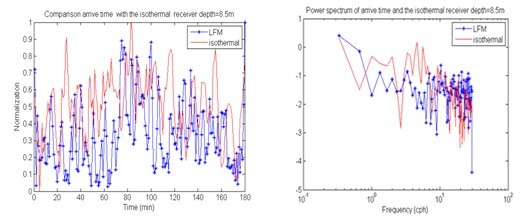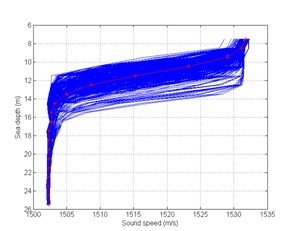
Acoustic Travel-time Fluctuates Due to Shallow-water Internal Waves in the Yellow Sea
May 23, 2014 Email"> PrintText Size

Internal waves cause sound speed profiles variations and have strong effects on acoustic propagation and scattering. Especially, high frequency internal waves can cause acoustic travel-time perturbations. Since the thermocline of Yellow Sea has a very thin layer with great temperature gradient, the specific ocean environment in Yellow Sea gives rise to this kind of particular ocean phenomenon and high frequency internal waves with sharp peak occurs frequently in the sea area.
A combined acoustics/physical oceanography experiment was performed to study both the acoustical properties and the ocean dynamics of the Yellow Sea in summer 2007. It was found that the high frequency internal waves (10-20 cph) had very strong influence on the acoustic travel-time fluctuation. Comparing the pattern of the displacement of thermocline and the pattern of modal travel time both on time domain and frequency domain, a certain degree of correlation could be found.
In Fig. 1, the waveform and power spectrum of travel time perturbation was compared with isothermal. The travel-time perturbations were in accord with the isothermal in the time domain and frequency domain. In other words, the travel-time perturbations were induced by the internal wave and in accord with the variation of the high frequency internal waves.

(a) Waveform comparison (b) Power spectrum comparison
Fig.1 comparison between the isothermal with the travel-time perturbations
(Receiver depth=8.5m) (Image by IOA).
In turn, the relation of modal travel time perturbation and the displacement of the thermocline is discussed. The Correspondence could be used to predict the activity of internal wave. A simple relation between the modal travel time perturbation and the displacement of the thermocline is developed.
The travel time perturbation  is 0.0074s at the receiver depth 13m. According to the formula, the displacement of the thermocline
is 0.0074s at the receiver depth 13m. According to the formula, the displacement of the thermocline  is 1.08m. The SSP variation in the experiment is shown in Fig. 2 and the corresponding
is 1.08m. The SSP variation in the experiment is shown in Fig. 2 and the corresponding  is about 1.05m. It shows that the SSP variation during the experiment is in accord with the prediction result according to the formula. As a result, the travel time fluctuation can be used to estimate the displacement of the thermocline.
is about 1.05m. It shows that the SSP variation during the experiment is in accord with the prediction result according to the formula. As a result, the travel time fluctuation can be used to estimate the displacement of the thermocline.

Fig. 2 The SSP variation during the experiments. The red star line was the mean value of the SSP (Image by IOA).
Journal References:
LI Fan, GUO Xinyi, HU Tao and MA Li. Acoustic Travel-time Perturbations Due to Shallow-water Internal Waves in the Yellow Sea. Journal of Computational Acoustics (vol. 22, no. 1, MAR 2014). DOI: 10.1142/S0218396X14400037
Corresponding Author:
LI Fan
Key Laboratory of Underwater Acoustic Environment, Chinese Academy of Sciences, Beijing 100190, China
E-mail: lifanyuxin@sina.com
Internal waves cause sound speed profiles variations and have strong effects on acoustic propagation and scattering. Especially, high frequency internal waves can cause acoustic travel-time perturbations. Since the thermocline of Yellow Sea has a very thin layer with great temperature gradient, the specific ocean environment in Yellow Sea gives rise to this kind of particular ocean phenomenon and high frequency internal waves with sharp peak occurs frequently in the sea area.
A combined acoustics/physical oceanography experiment was performed to study both the acoustical properties and the ocean dynamics of the Yellow Sea in summer 2007. It was found that the high frequency internal waves (10-20 cph) had very strong influence on the acoustic travel-time fluctuation. Comparing the pattern of the displacement of thermocline and the pattern of modal travel time both on time domain and frequency domain, a certain degree of correlation could be found.
In Fig. 1, the waveform and power spectrum of travel time perturbation was compared with isothermal. The travel-time perturbations were in accord with the isothermal in the time domain and frequency domain. In other words, the travel-time perturbations were induced by the internal wave and in accord with the variation of the high frequency internal waves.

(a) Waveform comparison (b) Power spectrum comparison
Fig.1 comparison between the isothermal with the travel-time perturbations
(Receiver depth=8.5m) (Image by IOA).
In turn, the relation of modal travel time perturbation and the displacement of the thermocline is discussed. The Correspondence could be used to predict the activity of internal wave. A simple relation between the modal travel time perturbation and the displacement of the thermocline is developed.
The travel time perturbation  is 0.0074s at the receiver depth 13m. According to the formula, the displacement of the thermocline
is 0.0074s at the receiver depth 13m. According to the formula, the displacement of the thermocline  is 1.08m. The SSP variation in the experiment is shown in Fig. 2 and the corresponding
is 1.08m. The SSP variation in the experiment is shown in Fig. 2 and the corresponding  is about 1.05m. It shows that the SSP variation during the experiment is in accord with the prediction result according to the formula. As a result, the travel time fluctuation can be used to estimate the displacement of the thermocline.
is about 1.05m. It shows that the SSP variation during the experiment is in accord with the prediction result according to the formula. As a result, the travel time fluctuation can be used to estimate the displacement of the thermocline.

Fig. 2 The SSP variation during the experiments. The red star line was the mean value of the SSP (Image by IOA).
Journal References:
LI Fan, GUO Xinyi, HU Tao and MA Li. Acoustic Travel-time Perturbations Due to Shallow-water Internal Waves in the Yellow Sea. Journal of Computational Acoustics (vol. 22, no. 1, MAR 2014). DOI: 10.1142/S0218396X14400037
Corresponding Author:
LI Fan
Key Laboratory of Underwater Acoustic Environment, Chinese Academy of Sciences, Beijing 100190, China
E-mail: lifanyuxin@sina.com
CAS Institutes
There are 124 Institutions directly under the CAS by the end of 2012, with 104 research institutes, five universities & supporting organizations, 12 management organizations that consist of the headquarters and branches, and three other units. Moreover, there are 25 legal entities affiliated and 22 CAS invested holding enterprisesThere are 124 I...>> more
Contact Us

Chinese Academy of Sciences
Add: 52 Sanlihe Rd., Xicheng District, Beijing, China
Postcode: 100864
Tel: 86-10-68597592 (day) 86-10-68597289 (night)
Fax: 86-10-68511095 (day) 86-10-68512458 (night)
E-mail: cas_en@cas.cn

